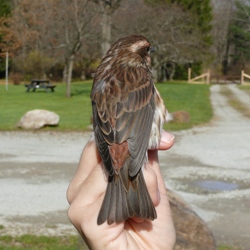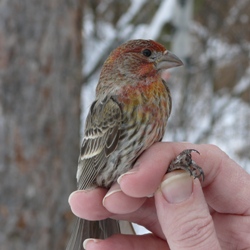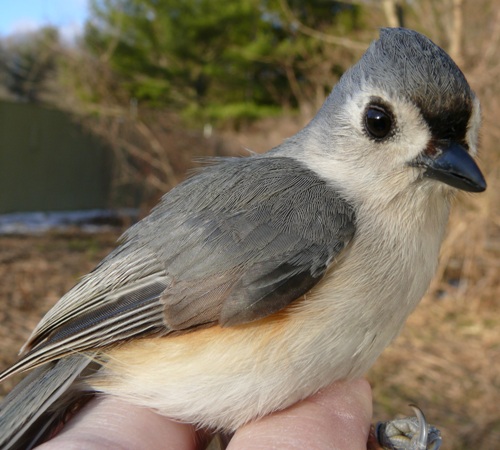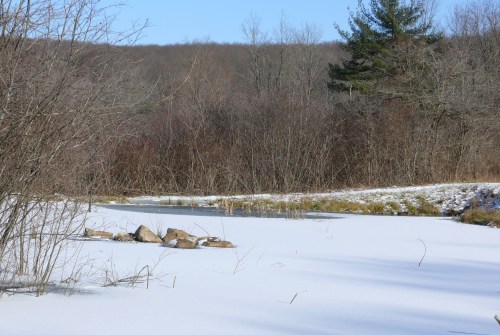November 11, 2013 - March 30, 2014



Over the winter we banded a total of 379 birds of 23 different species. Almost three quarters (72%) of these new captures were represented by our top three species (pictured above, left to right): Dark-eye Junco (115), American Goldfinch (112) and Song Sparrow (45). While captures of the first two species were spread out over the season, it is interesting to note that the majority of the Song Sparrows (39) were banded in March.

As mentioned in previous posts, we use both mist nets and potter traps to capture birds over the winter as weather permits. We banded a total of 42 days, only 16 of which we were able to use nets, 23 of which we used traps and three days where we used a combination of both.
Here, banding coordinator Luke DeGroote collects birds from the potter traps during one of the many winter snowstorms we banded through this season.
Pictorial Highlights for the season include...




These Purple finches, which weren't caught together, but they do offer us a worthy comparison between the male and female of this species. Note the purple wash of the male (left) covering the head, back, wing coverts and rump. He was banded on March 20th. We had an easy time aging him as after-second-year since the male Purple Finches do not attain their mature breeding plumage until their second prebasic molt (meaning this bird could not have hatched this past Summer).
Note the strong facial pattern of the female that clearly distinguishes her from the similar-looking House Finch females. This individual, a recapture (already banded) caught on November 15th and aged as an adult, had quite a bit of color for a female of this species, leading us to suspect that she was probably an older female.
Our banding records confirm that she was indeed originally banded on November 8, 2008 as an after-hatch-year, indicating that she was hatched at least as early as 2007 if not before, making this bird at least six years old. Interestingly, this was the first time she had been recaptured here since her original banding.


Noting the poorly developed color on this male House Finch, it should come as no surprise that this is a second-year bird. Young males are often not as vibrant and colorful as their adult counterparts. Still, it is a good comparison to the male Purple Finch. Note that the back of the House Finch does not show the distinctive red (in this case, reddish) plumage whereas the back of the male Purple Finch shows the purplish-red color from the head to the tail and across the wing coverts.

This Northern Cardinal, banded mid-February was one of 14 that we banded over the winter. Even though they are beautiful birds against a white winter background, we don't often photograph cardinals because they are fairly common here, and because when held in the photographer's grasp as seen here they frequently will...

...BITE! (Which we can assure you, they do quite well, as one can see from the imprint left on this photographer's hand.) Cardinals have such a powerful beak that adults are banded with a stronger band made of steel rather than our typical aluminum alloy bands. Though young cardinals beaks are nearly as powerful as the adults, young birds don't tend to bite their new bands as much and can therefore be banded with aluminum bands.

We had to wait until March 20th to add a Golden-Crowned Kinglet to our species list for 2014. The last two of this species were banded here on November 15 and 21. This individual was a second-year (hatched last summer) female.

We banded 8 White-breasted Nuthatches over the winter. This individual, a young female, was actually banded during the fall (October 23), but remained close to the banding station throughout the early part of winter. She was re-caught twice in November, then on December 16 (when this photo was taken) and again on January 8th.

This White-throated Sparrow was also a frequent visitor to our station this winter. We banded this second-year individual on February 15 and saw him again six times in March. We only banded one other White-throated Sparrow this winter, on November 19; that individual was caught just once.

Another sparrow we typically see over the winter is the American Tree Sparrow. This individual, an after-hatch-year banded on November 21st, was one of 15 banded here this winter.

Much less common in the cold winter months is the Field Sparrow. We had to wait until March 23 to band this individual, the only one banded before April. This was a young sparrow, hatched last summer, making this a second-year bird.

Another harbinger of spring is the Red-winged Blackbird. This handsome adult male was one of two that we banded on March 25th, the only two in our winter totals. Admiring the first-of-year bird is Bob Leberman, the original bander who started Powdermill banding in 1961.

Two of the photos we captured this winter provide us with opportunities to share information related to how we age birds using the molting of feathers.
Woodpeckers have interesting and complex molt patterns that allow us to age birds beyond the typical range of hatch-year through second year. Since woodpeckers do not molt all of their primary coverts all at once, even as adults, we can use these patterns to age the birds.
In this male Red-bellied Woodpecker (captured February 25th), several of the innermost and the one outer primary coverts have been replaced, while the three coverts between those are more brown and faded. However, the retained feathers are too high-quality to be juvenile feathers grown in the nest, so we were able to age this bird as an after-third-year (ATY).
Looking back at our data, we confirmed that this bird was banded in October of 2012 as a second-year bird. This was our twelfth encounter with this individual over the past 16 months.

Calling attention to the same group of feathers in this Tufted Titmouse, we can see that its primary coverts are very brown and show quite a bit of wear. We know that these brown primary coverts were grown in the nest, whereas the rest of the wing coverts and the alula feathers were replaced gradually in the fall once the bird had left the nest. At that time, since it was not growing all of its feathers at once, it had more nutrient resources to put into each feather, so the feathers are of a higher quality.

A close-up look at the primary coverts; note too that the flight feathers also look brown and abraded on the leading edge. These feathers were also grown in the nest and will not be replaced until this bird's 2nd prebasic molt in the fall.
We caught this Tufted titmouse just once this winter, on March 18th.

Over the winter, all of our ponds eventually froze over completely, but through the month of December, there was still one corner of Plover Pond that offered shelter and food sources for....

...this group of six Mallard Ducks. This picture was taken on December 12th, but by the end of the month, the ponds would freeze completely making it a winter too harsh for Mallards. A sentiment many but not all of the locals (humans) could agree with.
